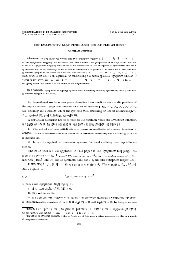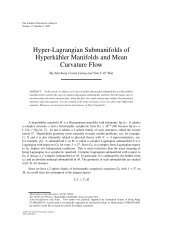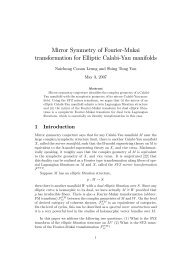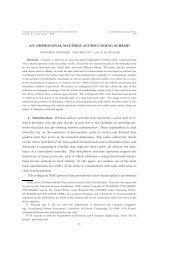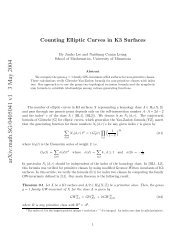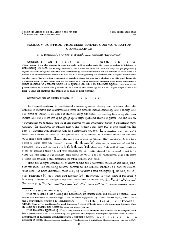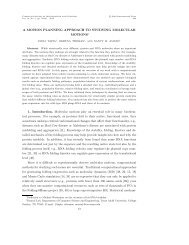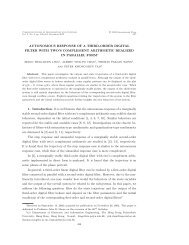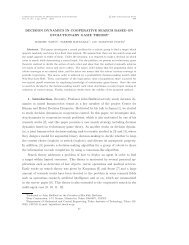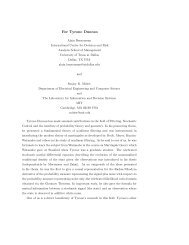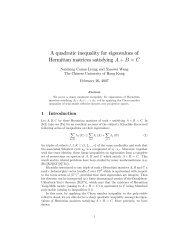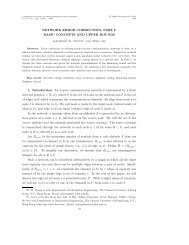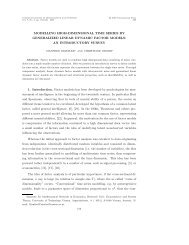AN OPTIMAL DISTRIBUTED ROUTING ALGORITHM USING DUAL ...
AN OPTIMAL DISTRIBUTED ROUTING ALGORITHM USING DUAL ...
AN OPTIMAL DISTRIBUTED ROUTING ALGORITHM USING DUAL ...
You also want an ePaper? Increase the reach of your titles
YUMPU automatically turns print PDFs into web optimized ePapers that Google loves.
296 PUNYASLOK PURKAYASTHA <strong>AN</strong>D JOHN S. BARAS<br />
surplus at nodes i, g i = ∑ j f(k) ji + r (k)<br />
i − ∑ j f(k) ij , are computed. A node i with positive<br />
surplus is chosen. (If all nodes have zero surplus, then the algorithm terminates,<br />
because the ǫ-complementary slackness conditions are satisfied and the flow balance<br />
conditions, too, are satisfied. The corresponding flow vector f is optimal.) The surplus<br />
g i is driven to zero at the iterative step, and another flow-price pair satisfying<br />
ǫ-complementary slackness is produced. At the same time the dual function (Q(p))<br />
value is increased, by changing the i-th price coordinate p i . At the iteration, except<br />
possibly for price p i at node i, the prices of the other nodes are left unchanged. It<br />
can be shown (even for z ij and C ij that are not necessarily integers, which is the case<br />
of interest to us; see [5]) that, if ǫ is chosen small enough, the algorithm converges to<br />
an optimal flow-price pair.<br />
Besides the ǫ-relaxation method, there exist other distributed algorithms, like<br />
the auction algorithm [1], that solve linear flow optimization problems. Any such<br />
algorithm can be used to solve the linear flow optimization problems at hand.<br />
4.2. Distributed Solution of the Dual Optimization Problem. We now<br />
focus on solving the dual problem using a distributed primal-dual algorithm. To that<br />
end, we first note that the dual function Q(z) is a non-differentiable function of z.<br />
This suggests that we can use a subgradient based iterative algorithm to compute an<br />
optimal dual vector z ∗ . We shall see that the computations can be made completely<br />
distributed.<br />
We first compute a subgradient for the concave function Q(z) at a point z (in<br />
R |L| ). Recall that a vector δ(z) is a subgradient of a concave function Q at z if<br />
(39) Q(w) ≤ Q(z) + δ(z) T (w − z), ∀w ∈ R |L| .<br />
Recall that for a given vector z, F(z) and f(z) denote a pair of vectors of total flows<br />
and commodity flows that attain the minimum in (32) and in (33), respectively. For<br />
vectors z,w, we have<br />
Q(w) − Q(z) = ∑ (<br />
)<br />
G ij (F ij (w)) − w ij F ij (w) + ∑<br />
(i,j)∈L<br />
k<br />
−<br />
∑ (<br />
)<br />
G ij (F ij (z)) − z ij F ij (z) − ∑ k<br />
(i,j)∈L<br />
∑<br />
(i,j)∈L<br />
∑<br />
(i,j)∈L<br />
w ij f (k)<br />
ij (w)<br />
z ij f (k)<br />
ij (z).<br />
Because<br />
≤<br />
∑<br />
(i,j)∈L<br />
∑<br />
(i,j)∈L<br />
(<br />
)<br />
G ij (F ij (w)) − w ij F ij (w) + ∑ k<br />
(<br />
)<br />
G ij (F ij (z)) − w ij F ij (z) + ∑ k<br />
∑<br />
(i,j)∈L<br />
∑<br />
(i,j)∈L<br />
w ij f (k)<br />
ij (w)<br />
w ij f (k)<br />
ij (z),




